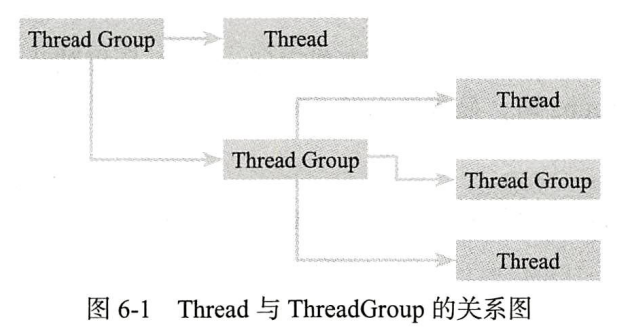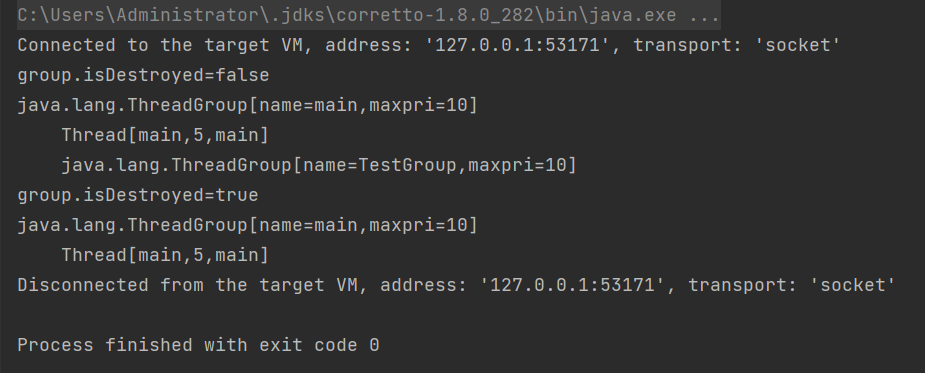1.ThreadGroup 与 Thread
在Java程序中, 默认情况下, 新的线程都会被加入到main线程所在的group中, main线程的group名字同线程名。如同线程存在父子关系一样, Thread Group同样也存在父子关系。图6-1就很好地说明了父子thread、父子thread Group以及thread和group之间的层次关系
2.创建ThreadGroup
创建Thread Group的语法如下:
public Thread Group(String name)public Thread Group(Thread Group parent, String name)
创建Thread Group的语法非常简单, 可通过上面某个构造函数来创建, 第一个构造函数为Thread Group赋予了名字, 但是该Thread Group的父Thread Group是创建它的线程所在的Thread Group; 第二个Thread Group的构造函数赋予group名字的同时又显式地指定了父Group。
public class TestThreadGroup {public static void main(String[] args) {ThreadGroup currentGroup = Thread.currentThread().getThreadGroup();ThreadGroup group1 = new ThreadGroup("group1");System.out.println(group1.getParent() == currentGroup);ThreadGroup group2 = new ThreadGroup(group1, "Group2");System.out.println(group2.getParent() == group1);}}
3.复制Thread数组和ThreadGroup数组
3,1复制Thread数组
public int enumerate(Thread[] list);public int enumerate(Thread[] list, boolean recurse);
上述两个方法, 会将Thread Group中的active线程全部复制到Thread数组中, 其中recurse参数如果为true, 则该方法会将所有子group中的active线程都递归到Thread数组中, enumerate(Thread[] list) 实际上等价于enumerate(Thread[] true) , 上面两个方法都调用了Thread Group的私有方法enumerate:
private int enumerate(Thread list[], int n, boolean recurse) {int ngroupsSnapshot = 0;ThreadGroup[] groupsSnapshot = null;synchronized (this) {if (destroyed) {return 0;}int nt = nthreads;if (nt > list.length - n) {nt = list.length - n;}for (int i = 0; i < nt; i++) {if (threads[i].isAlive()) {list[n++] = threads[i];}}if (recurse) {ngroupsSnapshot = ngroups;if (groups != null) {groupsSnapshot = Arrays.copyOf(groups, ngroupsSnapshot);} else {groupsSnapshot = null;}}}if (recurse) {for (int i = 0 ; i < ngroupsSnapshot ; i++) {n = groupsSnapshot[i].enumerate(list, n, true);}}return n;}
举一例:enumerate方法的使用
import java.util.concurrent.TimeUnit;public class TestThreadGroup {public static void main(String[] args) throws InterruptedException {ThreadGroup myGroup = new ThreadGroup("mygroup");Thread th = new Thread(myGroup,()-> {while(true) {try {TimeUnit.SECONDS.sleep(1);} catch (InterruptedException e) {e.printStackTrace();}}},"MyThread");th.start();TimeUnit.MILLISECONDS.sleep(2);ThreadGroup mainGroup = Thread.currentThread().getThreadGroup();Thread[] list = new Thread[mainGroup.activeCount()];int recuseSize = mainGroup.enumerate(list);System.out.println(recuseSize);recuseSize = mainGroup.enumerate(list,false);System.out.println(recuseSize);}}
上面的代码运行之后, 最后一个输出会比第一个少1, 那是因为代码中将递归recurse设置为了false, my Group中的线程将不会包含在内。
3.2 复制ThreadGroup数组
public int enumerate(Thread Group[] list);public int enumerate(Thread Group[] list, boolean recurse);
和复制Thread数组类似, 上述两个方法, 主要用于复制当前Thread Group的子Group,同样recurse会决定是否以递归的方式复制。
import java.util.concurrent.TimeUnit;public class TestCopyThreadGroup {public static void main(String[] args) throws InterruptedException {ThreadGroup myGroup1 = new ThreadGroup("MyGroup1");ThreadGroup myGroup2 = new ThreadGroup(myGroup1, "MyGroup2");TimeUnit.MILLISECONDS.sleep(2);ThreadGroup mainGroup = Thread.currentThread().getThreadGroup();ThreadGroup[] list = new ThreadGroup[mainGroup.activeCount()];int recurseSize = mainGroup.enumerate(list);System.out.println(recurseSize);recurseSize = mainGroup.enumerate(list,false);System.out.println(recurseSize);}}
在代码清单6-3中, my Group 1的父group为main Group, 而my Group 2的父group为my Group 1, 因此上述的代码运行之后, 递归复制的结果为2, 不递归的情况下为1。
4.ThreadGroup操作
4.1ThreadGroup的基本操作
- activeCount() 用于获取group中活跃的线程, 这只是个估计值, 并不能百分之百地保证数字一定正确, 原因前面已经分析过, 该方法会递归获取其他子group中的活跃线程。
- activeGroupCount() 用于获取group中活跃的子group, 这也是一个近似估值, 该方法也会递归获取所有的子group。
- getMaxPriority() 用于获取group的优先级,默认情况下,Group的优先级为10,在该group中, 所有线程的优先级都不能大于group的优先级。
- getName() 用于获取group的名字。
- getParent() 用于获取group的父group, 如果父group不存在, 则会返回null, 比如system group的父group就为null。
- list() 该方法没有返回值, 执行该方法会将group中所有的活跃线程信息全部输出到控制台, 也就是System.out。
- parentOf(Thread Group g) 会判断当前group是不是给定group的父group, 另外如果给定的group就是自己本身,那么该方法也会返回true。
- setMaxPriority(int pri) 会指定group的最大优先级, 最大优先级不能超过父group的最大优先级, 执行该方法不仅会改变当前group的最大优先级, 还会改变所有子group的最大优先级
import java.util.concurrent.TimeUnit;public class ThreadGroupBasic {public static void main(String[] args) {ThreadGroup group = new ThreadGroup("group1");Thread thread = new Thread(group,() -> {while(true) {try {TimeUnit.SECONDS.sleep(1);} catch (InterruptedException e) {e.printStackTrace();}}}, "thread");thread.setDaemon(true);thread.start();ThreadGroup mainGroup = Thread.currentThread().getThreadGroup();System.out.println("activeCount=" + mainGroup.activeCount());System.out.println("activeGroupCount=" + mainGroup.activeGroupCount());mainGroup.list();System.out.println("--------------------------");System.out.println("parentOf=" + mainGroup.parentOf(group));}}
4.2 ThreadGroup的interrupt
interrupt一个thread group会导致该group中所有的active线程都被interrupt, 也就是说该group中每一个线程的interrupt标识都被设置了, 下面是Thread Group interrupt方法的源码:
public final void interrupt() {int ngroupsSnapshot;ThreadGroup[] groupsSnapshot;synchronized (this) {checkAccess();for (int i = 0 ; i < nthreads ; i++) {threads[i].interrupt();}ngroupsSnapshot = ngroups;if (groups != null) {groupsSnapshot = Arrays.copyOf(groups, ngroupsSnapshot);} else {groupsSnapshot = null;}}for (int i = 0 ; i < ngroupsSnapshot ; i++) {groupsSnapshot[i].interrupt();}}
interrupt方法案例:
import java.util.concurrent.TimeUnit;public class TestThreadInterrupt {public static void main(String[] args) throws InterruptedException {ThreadGroup group = new ThreadGroup("TestGroup");new Thread(group,() -> {while(true) {try {TimeUnit.MILLISECONDS.sleep(2);} catch (InterruptedException e) {e.printStackTrace();}}},"t1").start();new Thread(group,()-> {try {TimeUnit.MILLISECONDS.sleep(1);} catch (InterruptedException e) {e.printStackTrace();}},"t2").start();TimeUnit.MILLISECONDS.sleep(2);group.interrupt();}}
4.3ThreadGroup的destroy
destroy用于销毁Thread Group, 该方法只是针对一个没有任何active线程的group进行一次destroy标记, 调用该方法的直接结果是在父group中将自己移除:
测试代码:
public class ThreadGroupDestroy {public static void main(String[] args) {ThreadGroup group = new ThreadGroup("TestGroup");ThreadGroup mainGroup = Thread.currentThread().getThreadGroup();System.out.println("group.isDestroyed=" + group.isDestroyed());mainGroup.list();group.destroy();System.out.println("group.isDestroyed=" + group.isDestroyed());mainGroup.list();}}

4.4守护ThreadGroup
线程可以设置为守护线程, Thread Group也可以设置为守护Thread Group, 但是若将一个Thread Group设置为daemon, 也并不会影响线程的daemon属性, 如果一个Thread Group的daemon被设置为true, 那么在group中没有任何active线程的时候该group将自动destroy, 下面我们给出一个简单的例子来对其进行说明:
import java.util.concurrent.TimeUnit;public class ThreadGroupDaemon {public static void main(String[] args) throws InterruptedException {ThreadGroup group = new ThreadGroup("Group1");new Thread(group,()-> {try {TimeUnit.SECONDS.sleep(1);} catch (InterruptedException e) {e.printStackTrace();}},"group1-thread1").start();ThreadGroup group2 = new ThreadGroup("Group2");new Thread(group2,()-> {try {TimeUnit.SECONDS.sleep(1);} catch (InterruptedException e) {e.printStackTrace();}},"group2-thread1").start();group2.setDaemon(true);TimeUnit.SECONDS.sleep(3);System.out.println(group.isDestroyed());System.out.println(group2.isDestroyed());}}
在上面的代码中, 第二个group的daemon被设置为true, 当其中没有active线程的时候, 该group将会自动被destroy, 而第一个group则相反。

